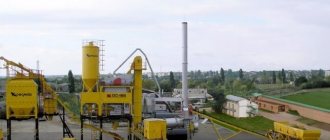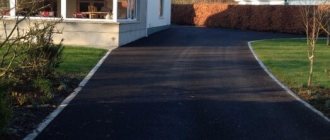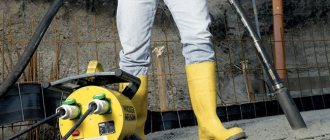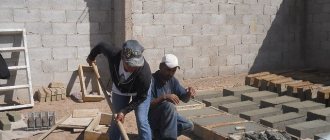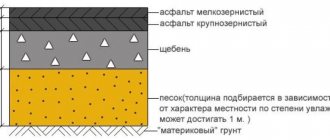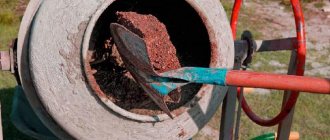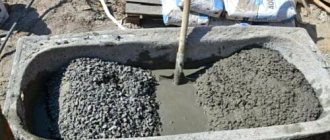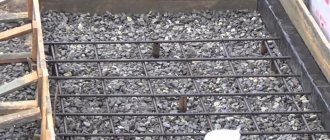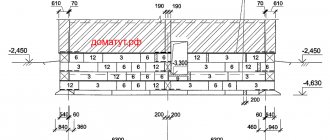- 1 What ingredients are used in the mixture?
- 2 What algorithms exist for designing the component composition of asphalt concrete?
- 3 Example of optimal selection of asphalt concrete mixture ingredients
Asphalt concrete mixture is a building material obtained artificially. According to the production technology, a rational selection of the main components is carried out, and then the material is compacted with vibrators. Requirements for the characteristics of asphalt concrete composition are included in GOST 9128.
What ingredients are used in the mixture?
The asphalt concrete solution contains the following ingredients:
- components of mineral origin, such as natural or crushed sand, crushed stone (gravel), fine powder admixtures (if necessary);
- binders of organic origin, such as bitumen.
- compacted;
- cast, it is characterized by high fluidity and a high content of binder material, therefore it allows masonry to be carried out without compaction.
The composition of asphalt concrete is:
- crushed stone;
- gravel;
- sandy.
The viscosity of bitumen and the maximum temperature of the masonry determine the following types of mixtures:
However, the latter type has not been found as a separate species since 1999. Types of hot asphalt concrete based on residual percentage porosity:
- high-density - 1-2.5%;
- highly porous - 10-18%;
- dense - 2.5-5%;
- porous - 5-10%.
In cold solutions this value is 6-10%. According to the maximum particle size of the mineral component used, the asphalt concrete sheet can be:
- coarse-grained with particle size up to 4 cm;
- fine-grained with particles up to 2 cm;
- sandy with a size of up to 5 cm.
- type A, in which the composition of the mineral stone is 50-60%;
- type B with stone content 40-50%;
- type B, including 30-40% filler.
An example of the optimal selection of asphalt concrete mixture ingredients
As an example of asphalt concrete components, it is proposed to consider the problem: a fine-grained hot mixture of type B of the second grade is needed to create a dense top ball of the road in the third climatic zone. The following ingredients are available:
- granite and limestone crushed stone with a grain size of 0.5-2 cm;
- river sand;
- screening after grinding granite chips;
- screenings after crushing limestone;
- non-activated mineral powder;
- bitumen material BND 90/130.
In this way, the amount of crushed stone in the mixture for the fractional composition is calculated.
Due to the presence of particles less than 0.0071 cm from granite screenings in the mixture, the minpowder fraction is taken equal to 8%. At the fourth stage, the amount of sand is calculated. Its general content is:
Sand =100 - (Crushed stone minpowder) = 100 - (50
= 42%.
- three minutes on a vibration platform at a pressure of 0.03 MPa;
- three-minute compaction on a vibropress at a pressure of 20 MPa.
Next, three more asphalt concrete samples with a bitumen content of 6.2% are prepared to determine the residual porosity. If its value is 4.0 ± 0.5%, additional 15 samples of such a mixture are prepared and tested in accordance with GOST 9128-84.
If a discrepancy with the requirements of the regulatory document is detected, the mixture is adjusted and subsequently tested, as indicated above.
“Asphalt concrete mixtures and asphalt concrete. Asphalt concrete design"
The topic of roads has always been a problem for our state. Therefore, the correct selection of materials for road construction will ensure the durability and reliability of the road structure. And good roads are an indicator of the economic stability of the state and the quality of life of its citizens.
Asphalt concrete is the most common material for constructing road surfaces. Therefore, knowledge of this material, the ability to correctly navigate its properties and features, understand its varieties, and the ability to choose the right composition is the necessary minimum that a road construction technician should have.
Definition of the subject of research: Asphalt concrete, its classification and application features.
The purpose of this research project is to design an asphalt concrete composition that ensures the quality and durability of the road surface for the given situational task: “An Amur entrepreneur opens an agricultural enterprise (pig farm) in the Blagoveshchensky district near the village of Belogorye.” It is necessary to improve the dirt road by laying a 2-layer asphalt concrete surface. The terrain is flat, with some areas on low hills. Select the type, type and brand of asphalt concrete for each layer of road pavement, focusing on local road construction materials. The category of the road must be decided independently. Justify the choice made and prove the benefits of this asphalt concrete.”
Research objectives:
- Study asphalt concrete, its properties and classification;
- Study and analyze the conditions of road construction;
- Design the type, type and grade of asphalt concrete depending on the climatic and geological conditions of the area and the category of the road;
- Calculate the composition of asphalt concrete;
- To prove the feasibility and benefits of using this asphalt concrete.
Hypothesis: For this road it is more expedient to use hot asphalt concrete.
Asphalt concrete is a building material in the form of a compacted mixture of crushed stone, sand, mineral powder and bitumen. Before mixing, the components are dried and heated to a temperature of 100-160°C. There are hot asphalt concrete containing viscous bitumen, laid and compacted at a mixture temperature of at least 120°C; cold - with liquid bitumen, compacted at an ambient temperature of at least 10°C and a mixture temperature of at least 50C. Asphalt concrete is used for road surfaces, airfields, exploited flat roofs, and in hydraulic engineering construction. Depending on the loads and climatic conditions, asphalt concrete is subject to appropriate requirements for density, strength, shear resistance, and water resistance. To prepare asphalt concrete, fractionated mineral materials and bitumens are used, the quality of which is regulated by state standards.
Material requirements:
Crushed stone and gravel. To prepare asphalt concrete mixtures, you should use gravel crushed stone for construction work in accordance with GOST 8267-93, crushed stone from metallurgical slag in accordance with GOST 3344-83. Crushed stone with a grain size finer than 20 mm is intended for the preparation of fine-grained asphalt concrete mixtures, finer than 40 mm for coarse-grained ones.
For mixtures of type B III grade, intended for the top layer of artificial turf, it is not recommended to use uncrushed gravel.
The weighted average content of lamellar (flaky) and needle-shaped grains in a mixture of crushed stone and gravel fractions should be, % by weight, no more than: 15 - for type A and high-density mixtures; 25 - for mixtures of types B and highly porous; 35 - for mixtures of types B and porous.
Sand. Natural sand and sand from rock crushing screenings must comply with the requirements of GOST 8736.
To prepare asphalt concrete mixtures, natural and crushed sands, as well as screenings of crushed products, should be used.
Sand can be used as a component of crushed stone mixtures, and also as an independent filler in sand asphalt concrete.
Depending on the size of natural sand, the content of dust and clay particles should not exceed 3% by weight, in crushed sand - 5%.
Mineral powder. To prepare asphalt concrete mixtures, activated and non-activated mineral powders (GOST 16557-78), produced by grinding carbonate rocks, should be used. The use of mineral powders is mandatory in asphalt concrete grades I-II, intended for use in climatic zones I-III. Under these same conditions, preference should be given to activated mineral powders, which provide increased density, water and frost resistance of asphalt concrete pavements.
In hot mixes for dense asphalt concrete grades II - III, it is allowed to use finely ground basic metallurgical slag as a mineral powder, as well as self-disintegrating metallurgical slag, which may include ferropol - a waste product from ferrochrome smelting plants. Other powder industrial waste, for example, fly dust from cement factories, fly ash from thermal power plants, etc., can be used in hot mixes for dense asphalt concrete of grade III and grades I-II for porous and highly porous asphalt concrete.
The use of all industrial waste powders as mineral powder should be allowed only if the entire complex of physical and mechanical properties of asphalt concrete fully complies with the requirements of GOST 9128-2009.
Bitumen. Bitumen are organic binders consisting of high molecular weight hydrocarbons: naphthenic, methane and aromatic, as well as oxygen, sulfur and nitrogen derivatives.
To prepare asphalt concrete mixtures, petroleum road viscous and petroleum road liquid bitumens are used. For hot asphalt concrete mixtures of grades I and II, only bitumen of grades BND should be used, and for hot asphalt concrete mixtures of grades III and IV, as well as for asphalt concrete mixtures intended for the construction of bases and lower layers of pavements, along with bitumen of grades BND, the use of grades BN is also allowed appropriate viscosity.
The choice of the optimal composition of asphalt concrete is usually made depending on the properties of the source materials, the nature of traffic and the climatic conditions of the area, which has always been a determining condition for the construction of durable asphalt concrete pavements.
At the development stage of a highway project, a certain type of asphalt concrete is selected, specifically for each structural layer of the road pavement.
Only dense asphalt concrete is used in the upper layers of pavements on roads of all categories.
The lower layers of pavements on roads of categories I - II are made of porous asphalt concrete, and on roads of categories III - IV - from highly porous asphalt concrete.
To create a good asphalt surface, it is necessary to provide it with a reliable base using crushed stone and sand. In this case, crushed stone is laid in larger fractions downwards, and in smaller fractions in the upper layers of the pavement, which not only improves the quality of the road, but also reduces the costs of its construction.
The type and type of dense asphalt concrete for the top layers of pavement are prescribed depending on the category of the road and the climatic conditions of the construction area.
Based on the conditions of the problem, we will lay a two-layer asphalt concrete pavement on the road Blagoveshchensk - Belogorye, passing through Mokhovaya Pad. Since the road is intended not only to meet the needs of the farm, but also provides transport links to populated areas and several recreation centers located along this route, the traffic intensity and load on the road will be high, both cars and trucks will pass along it, providing future farms, tourist centers and settlements with raw materials and exporting products. This road is classified as a public road of regional property. The estimated traffic intensity will be up to 6,000 vehicles per day, which corresponds to the III technical category of the road.
Analysis of climatic conditions:
The climate of the Amur Region is sharply continental with monsoonal features. The climate is primarily characterized by the temperature of the coldest and warmest months. Identical indicators of different places are combined by isotherms. Winter in the region is harsh. At the latitude of Blagoveshchensk, January temperatures vary from −24 °C to −27 °C. There are frosts down to −44 °C. Summer in the south of the region is warm. The isotherms here range from 18 °C to 21 °C. Average absolute maximum temperatures can reach up to 42 °C. The annual precipitation in Blagoveshchensk is up to 550 mm.
The entire region is characterized by a summer maximum precipitation, which is due to the monsoon climate. During June, July and August, up to 70% of the annual precipitation can fall. There may be fluctuations in precipitation. Thus, in summer, with increasing evaporation, absolute and relative humidity increases, and in spring, due to dry air, the snow cover mostly evaporates, and the consequence of this is a slight spring rise in water levels in rivers.
Such climatic conditions are typical for road climate zone III. Construction is planned for the spring (April), that is, it will be carried out in a favorable (warm, dry) period, so it is advisable to use hot mix asphalt concrete. For hot mixes in average conditions of Russia (climatic zones II and III), bitumens with a viscosity of 60 are mainly used /90, 90/130, 130/200. The main thing when choosing a brand of bitumen is the climatic conditions and the load on the layers of road pavement, that is, the category of the road. The recommended area of application of asphalt concrete and bitumen when constructing the top layers of road surfaces, taking into account climatic conditions, is given in the Appendix AGOSTA9128-2009.
The quality of BND bitumens is higher than BN, since they are characterized by a wider temperature range of plasticity and higher heat resistance, have a low brittleness temperature, better adhesion to the surface of grains of mineral material, but are less resistant to aging.
Based on the indicated properties of bitumen, taking into account the construction time, climate conditions and road category, we select BND 90/130 grade bitumen.
In areas of the III road-climatic zone, characterized by a fairly cold and humid climate, during the construction of the top layer of pavements on roads of the third category, hot mixtures of types A, B, C, D and D of grade II can be used. To install the top layer of pavement, based on the technical category of this road, it is advisable to use a fine-grained mixture of type B containing crushed stone of 40 - 50% grade II, in which a transitional type structure is formed, largely with closed pores that prevent water from penetrating into the pavement. At the same time, since our road goes through hills and has a slope, this type of asphalt concrete has a fairly rough texture, which provides good adhesion of the car wheel to the surface and guarantees safe movement. In addition, to increase the roughness in the top layer when rolling asphalt concrete on slopes, we will embed black crushed stone fraction 5–20mm.
For the bottom layer, we chose highly porous asphalt concrete, characterized by a low bitumen content. Reducing the consumption of bitumen in asphalt concrete mixtures will reduce the cost of pavement while ensuring the required quality of pavement bases. Highly porous asphalt concrete is recommended for constructing bases for asphalt concrete pavements on roads of categories II and III. We use highly porous crushed stone coarse-grained asphalt concrete grade I, using crushed stone of a fraction of 20 - 40 mm.
As stone materials, having analyzed the availability and economic benefits, we will use: crushed stone and screenings of Gravelon LLC, this company is registered at Blagoveshchensk, st. Ignatievskoye Highway, 24 - office 303; 3rd floor. Today, Gravelon is the only company engaged in the production of crushed stone in close proximity to Blagoveshchensk: the deposit is located just 15 kilometers from the regional center. The products of Gravelon LLC meet the requirements in all respects in the construction and road industries - this has been confirmed laboratory research. River sand - produced by Pharaon LLC, this company is registered at 675520, Amur region, Blagoveshchensky district, village. Chigiri, st. Novaya, no. 4. In the project we focus on local, and therefore the most cost-effective, but at the same time high-quality materials.
There are two approaches to designing the composition of asphalt concrete mixtures. The first is the selection of a mixture with a continuous granulometry of the stone material (the so-called Macadam). This option guarantees high mechanical properties of the coating due to the wedging of smaller fractions of crushed stone into larger fractions. The coating, made from a mixture with continuous granulometry of the mineral part, has high roughness and shear resistance. The properties of the mixture do not change as a result of deviations in the dosage of mineral powder and bitumen; it is easily distributed, formed and compacted during the coating process. With the second method of selecting a mixture - according to the principle of dense concrete - it is allowed to use stone materials with a rounded grain shape and discontinuous granulometry. In the process of compacting these mixtures, asphalt concrete with closed porosity is formed, the coating acquires higher water resistance and frost resistance. However, such mixtures are more prone to uneven distribution of grains of the mineral component and bitumen in the volume. Their physical and mechanical properties are greatly influenced by deviations in the dosage of mineral powder and bitumen. Coatings made from mixtures selected according to the principle of dense concrete are characterized by low roughness.
We use the Macadam method.
To prepare a hot asphalt concrete mixture (type B, grade II) for the top layer of the coating, we accept the following materials: fractionated granite crushed stone (fractions 20 - 10 and 15 -5) with a true density ρ = 2620 kg/m3; granite screenings with a density ρ = 2760 kg/ m3; quartz river sand with a density ρ=2700kg/m3; limestone powder with a density ρ=2910kg/m3. The grain compositions of the materials are given in partial percentages:
| Material | Grain content in %, larger than a given size in mm | ||||||||||
| 20 | 15 | 10 | 5 | 2,5 | 1,25 | 0,63 | 0,315 | 0,16 | 0,071 | <0,071 | |
| Crushed stone 20-10 | 3 | 41 | 54 | 2 | — | — | — | — | — | — | — |
| Crushed stone 15-5 | — | 5 | 38 | 54 | 3 | — | — | — | — | — | — |
| Dropout | — | — | — | 13 | 27 | 30 | 10 | 7 | 6 | 4 | 3 |
| Sand | — | — | — | — | 12 | 18 | 47 | 5 | 8 | 8 | 2 |
| Min. powder | — | — | — | — | — | — | 2 | 3 | 5 | 15 | 75 |
Let's calculate the composition of mineral components. We carry out the calculation in tabular form, first calculating the total residues on the sieves, and then the total residues, taking into account the proportional content of each material in the mineral mixture. We calculate the percentage content of each material based on those recommended by GOST.
The calculation of the mineral part of asphalt concrete in total residues is given in the table:
| Material | Grain content in %, larger than a given size in mm | D.S. | ||||||||||
| 20 | 15 | 10 | 5 | 2,5 | 1,25 | 0,63 | 0,315 | 0,16 | 0,071 | <0,071 | ||
| Rec. floor limits residues for small grains. a/concrete type B (GOST 9128-9) | 0 — 10 | 0 — 20 | 0 — 30 | 40 — 50 | 52 — 62 | 63 — 72 | 72 — 80 | 78 — 86 | 84 — 90 | 88 — 94 | 100 | |
| Crushed stone 20-10 | 3 | 44 | 98 | 100 | 100 | 100 | 100 | 100 | 100 | 100 | 100 | |
| Crushed stone 15-5 | — | 5 | 43 | 97 | 100 | 100 | 100 | 100 | 100 | 100 | 100 | |
| Dropout | — | — | — | 13 | 40 | 70 | 80 | 87 | 93 | 97 | 100 | |
| Sand | — | — | — | — | 12 | 30 | 77 | 82 | 90 | 98 | 100 | |
| Min. powder | — | — | — | — | — | — | 2 | 5 | 10 | 25 | 100 | |
| Crushed stone 20-10 | 0,45 | 6,6 | 14,7 | 15 | 15 | 15 | 15 | 15 | 15 | 15 | 15 | 0,15 |
| Crushed stone 15-5 | — | 1,55 | 13,33 | 30,07 | 31 | 31 | 31 | 31 | 31 | 31 | 31 | 0,31 |
| Dropout | — | — | — | 2,86 | 8,8 | 15,4 | 17,6 | 19,14 | 20,46 | 21,31 | 22 | 0,22 |
| Sand | — | — | — | — | 2,64 | 6,6 | 16,04 | 18,04 | 19,8 | 21,56 | 22 | 0,22 |
| Min. powder | — | — | — | — | — | — | 0,2 | 0,5 | 1 | 2,5 | 10 | 0,1 |
| Sum | 0,45 | 8,15 | 28,03 | 47,93 | 57,44 | 68 | 79,84 | 83,68 | 87,26 | 91,4 | 100 | |
The fractional content of crushed stone 20-10 is determined using sieve No. 10. 0÷30% is recommended, 15% is accepted. D.S. = =0.15. For crushed stone 15 - 5, 40÷50% is recommended, and for coarse crushed stone on sieve No. 5 we already have 15%, so we recommend 25÷35%, D.S. = =0.31. For mineral powder it should be 100-(88÷94)= 12÷6%, D.S.= =0.12. We accept D.S. = 0.1. Sand and screenings account for D.S.=1-(0.31+0.15+0.1)=0.44. Screening increases the roughness and shear resistance of the coating, but increases the cost of asphalt concrete, so in order not to increase the cost of asphalt concrete, we accept the ratio of screenings and river sand as 50/50. D.S. sand = 0.22, D.S. dropout rate = 0.22
Correction factor = material density / base material density
The updated content of mineral materials is given in the table:
| Material | True density | Corrective coefficient | Contents of materials | ||
| Volume fractions | Mass fractions | % by mass | |||
| Crushed stone 20-10 | 2620 | 1 | 0,15 | 0,15 | 14,6 |
| Crushed stone15-5 | 2620 | 1 | 0,31 | 0,31 | 30,1 |
| Dropout | 2760 | 1,05 | 0,22 | 0,23 | 22,3 |
| River sand | 2700 | 1,04 | 0,22 | 0,229 | 22,2 |
| Min. powder | 2910 | 1,11 | 0,10 | 0,111 | 10,8 |
| Total | 1 | 1,03 | 100 | ||
The bitumen content in the mixture is preliminarily selected in accordance with the recommendations of Appendix G of GOST 9128-2009 and taking into account the standard requirements for the residual porosity of asphalt concrete for a specific climatic region. Bitumen for hot dense asphalt concrete type B is recommended at 5 – 6.5%.
We calculate the optimal amount of bitumen based on the bitumen capacity of the materials included in the asphalt concrete mixture. To do this, we first calculate the grain composition of the materials, considering the rocks from which the stone materials are produced:
| Material | Residues on sieves | Sieve size, mm | ||||||||||
| 20 | 15 | 10 | 5 | 2,5 | 1,25 | 0,63 | 0,315 | 0,16 | 0,071 | < 0,071 | ||
| Granite | BY | 0,45 | 8,15 | 28,03 | 47,93 | 54,8 | 61,4 | 63,6 | 65,14 | 66,46 | 67,34 | 68 |
| P.O. | 0,45 | 7,7 | 19,88 | 19,9 | 6,87 | 6,6 | 2,2 | 1,54 | 1,32 | 0,88 | 0,66 | |
| Limestone | BY | — | — | — | — | — | — | 0,2 | 0,5 | 1 | 2,5 | 10 |
| P.O. | — | — | — | — | — | — | 0,2 | 0,3 | 0,5 | 1,5 | 7,5 | |
| Sand | BY | — | — | — | — | 2,64 | 6,6 | 16,94 | 18,04 | 19,8 | 21,56 | 22 |
| P.O. | — | — | — | — | 2,64 | 3,96 | 10,34 | 1,1 | 1,76 | 1,76 | 0,46 | |
Bitumen quantity:
| Fraction size | Partial remainder of an integer | Bitumen capacity, % | Amount of bitumen,% | ||||
| Granite | Limestone | Sand | Granite | Limestone | Sand | ||
| 20-25 | 0,0045 | — | — | 4,5 | — | — | 0,0202 |
| 15-20 | 0,077 | — | — | 4,5 | — | — | 0,3465 |
| 10-15 | 0,198 | — | — | 4,7 | — | — | 0,9306 |
| 5-10 | 0,199 | — | — | 5,2 | — | — | 1,0348 |
| 2,5-5 | 0,0951 | — | 0,0264 | 5,5 | — | 3,3 | 1,0348+0,0871=1,1219 |
| 1,25-2,5 | 0,1056 | — | 0,0396 | 5,7 | — | 3,8 | 0,6019+0,1504=0,7523 |
| 0,63-1,25 | 0,1254 | 0,002 | 0,1034 | 5,9 | 6,0 | 4,6 | 0,73986+0,012+0,47564=1,2275 |
| 0,315-0,63 | 0,029 | 0,003 | 0,011 | 6,4 | 7,0 | 4,8 | 0,1856+0,021+0,0528=0,2594 |
| 0,16-0,315 | 0,0276 | 0,005 | 0,0176 | 7,4 | 7,3 | 6,1 | 0,20424+0,0365+0,10736=0,34801 |
| 0,071-0,16 | 0,027 | 0,015 | 0,0176 | 8,4 | 9,4 | 7,0 | 0,2268+0,141+0,16544=0,3678 |
| <0,071 | 0,0066 | 0,075 | 0,0046 | 18 | 16 | 14 | 0,00891+1,2+0,064=1,27331 |
| Total | 5,80821 | ||||||
In the laboratory, three samples are prepared from an asphalt concrete mixture with a calculated amount of bitumen and determined: the average density of asphalt concrete, the average and true density of the mineral part, the porosity of the mineral part and the residual porosity of asphalt concrete according to GOST 12801-98. If the residual porosity does not correspond to the selected one, then the required content of bitumen B (%) is calculated from the obtained characteristics using the formula
where V°pop is the porosity of the mineral part, % volume; Vmpor - selected residual porosity, % volume, is taken in accordance with GOST 9128-2009 for a given road-climatic zone; rb is the true density of bitumen, g/cm3; rb = 1 g/cm3; rмm—average density of the mineral part, g/cm3. Having calculated the required amount of bitumen, the mixture is prepared again, three samples are formed from it and the residual porosity of the asphalt concrete is determined. If the residual porosity coincides with the selected one, then the calculated amount of bitumen is accepted. Since we are not able to mold the samples due to a lack of equipment, we consider this to be the end of our research.
Having carried out our research work with normative literature and Internet sources, we obtained the following results for solving a specific situational problem:
- Technical category of the road – III ;
- Road climatic zone of the construction site – III ;
- Mineral materials are delivered: from Gravilon LLC - crushed stone and screenings; from Pharaon LLC - quartz river sand ;
- Depending on the climatic conditions, the category of the road, the geological structure of the area, hot asphalt concrete was selected, prepared using BND 90/130 grade bitumen ;
- For the bottom layer of the coating - hot, highly porous crushed stone asphalt concrete, grade I, coarse-grained, using crushed stone of a fraction of 20 - 40 mm ;
- For the top layer of the coating - hot dense asphalt concrete grade II, type B, fine-grained, using crushed stone of a fraction of 10 - 20mm .
Based on the materials used, we calculated the composition of asphalt concrete for the top layer of the coating:
Crushed granite fraction 20 – 10 mm – 14.6%;
Crushed granite fraction 15 – 5 mm – 30.1%;
Screening granite - 22.3%;
River quartz sand - 22.2%;
Limestone mineral powder - 10.8%;
Viscous bitumen grade BND 90/130 - 5.8% by weight of the mineral mixture.
We proved in the process of research that hot-mix asphalt concrete is more appropriate for pavement of this road, since it is suitable for both the top and bottom layers. Recommended for road climate zone III, applicable during the spring construction period. Allows you to start the movement of vehicles on the road in a shorter time compared to cold asphalt - the structure of hot asphalt concrete is formed immediately after compaction and cooling of the asphalt to ambient temperature. Hot asphalt concrete is more resistant to the effects of cars and atmospheric factors. That is, the hypothesis is confirmed.
For our country, asphalt concrete is the main material for road construction, and now we know “why”, we know its main advantages. Compared to cement concrete, it is a less rigid and more plastic material, and most of Russia is located in a territory characterized by a large difference in average annual, and in some places, average daily temperatures. The deformability of asphalt concrete ensures its durability. In addition, after hardening it becomes more even, which means less noisy and has the necessary roughness. Secondly, you can immediately open traffic on laid asphalt concrete and not wait for it to harden, unlike cement concrete, which gains the necessary strength only on the 28th day. Thirdly, asphalt concrete pavement is easy to repair, wash, clean, and any markings adhere well to it.
Literature and Internet sources
- Road Master's Handbook. Construction, operation and repair of highways. M.: “Infra-Engineering”, 2005
- GOST 9128-2009 Asphalt concrete mixtures for road, airfield and asphalt concrete. Technical conditions.
- SP 78.13330.2012 “Highways”
- Federal State Unitary Enterprise "Information Center for Highways". Highways and bridges. Design of asphalt concrete composition and methods of its testing. Overview information. Issue 6. M. 2005.
- Wikipedia, free encyclopedia [Electronic resource]. – Asphalt concrete. – Access mode: https://ru.wikipedia.org/, free
- "Gravilon". Extraction of building stone, production of crushed stone. Stability, Quality, Reliability. [Electronic resource]. – access mode: https://gravelon.ru/, free
- Dorcomtech. [Electronic resource]. — Brands and composition of asphalt. – Access mode: https://dorkomteh.ru, free
Production and laying of asphalt concrete
The preparation of asphalt concrete begins with the factory production of asphalt mixture and ends with its placement and compaction into the road surface at the construction site.
- The hot or warm mixture is laid out in such a way that the thickness of the laid layer is 15–20% greater than the design value. For cold mixtures, this parameter is 50–60%
- The stacked volumes are compacted with static motor (weight 5–14 tons) or vibromotor rollers (weight 0.5–4.5 tons).
Having considered the technology described above, we can conclude that it is simply impractical to produce asphalt concrete at home with your own hands, given the labor intensity associated with heating and mixing the necessary components.
Individual developers usually use factory-prepared cold mixtures for landscaping their local area. This composition of asphalt concrete allows for laying even at sub-zero temperatures.
GENERAL PROVISIONS
1.2. Selection of concrete composition includes: determination of the nominal composition, calculation and adjustment of the working composition, calculation and transfer of working dosages to production.
Subsequently, based on the results of operational quality control of materials from these batches and the concrete mixture obtained from them, as well as acceptance control of concrete quality, adjustments are made to the working compositions.
1.5. The working dosage is determined according to the working composition of the concrete mixture, taking into account the volume of the batch being prepared.
1.6. The selection of concrete composition must be carried out by the laboratory of the concrete mixture manufacturer according to an approved specification developed by the technological service of this enterprise.
It is allowed to select the composition of concrete in central laboratories, trusts "Orgtekhstroy", research laboratories and other organizations according to the approved specification for the selection of concrete composition.
What algorithms exist for designing the component composition of asphalt concrete?
To select the composition of the asphalt concrete solution, a rational ratio of components is selected. The resulting compositions have a given density and technical properties. There are four design algorithms:
- Method of Professor P.V. Sakharov
- Modulo saturation method provided by Professor Durieu M.
- Design algorithm for the required operating conditions of the coating, obtained through the research of Professor I. A. Rybyev.
- Selection based on density curves, developed by Professor N.I. Ivanov with the assistance of SoyuzDorNII.
Return to contents
SELECTION OF NOMINAL CONCRETE COMPOSITION
3.1. The selection of the nominal composition of concrete is carried out according to the following steps:
selection and determination of the characteristics of raw materials for concrete;
calculation of the initial composition;
calculation of additional concrete compositions with composition parameters that differ from those accepted in the initial composition to a greater or lesser extent;
production of test batches of initial and additional compositions, sampling, testing of concrete mixtures, production of samples and their testing according to all standardized quality indicators;
designation of the nominal composition of concrete, ensuring the production of a concrete mixture and concrete of the required quality with a minimum consumption of binder.
3.2. The selection of the nominal composition is carried out:
Kawabanga! Curd product
for binder of each type and brand of each manufacturer;
for coarse aggregate in each quarry with the same maximum size;
for large porous filler of each brand according to bulk density and strength of each manufacturer;
for the sands of each quarry;
for chemical additives of each type.
3.3. The choice of materials used for the manufacture of concrete should be made on the basis of their passport characteristics in accordance with the requirements of standards and technical specifications.
When choosing materials, one should take into account the need for the fullest use of industrial waste (ash, slag and ash and slag mixtures from thermal power plants, etc.).
The specified data on the actual strength of cement, used in the selection of the nominal composition, are used in the future to assign working compositions of concrete.
3.5. Material samples are taken in the amount necessary to select the concrete composition.
Selected samples of aggregates should be dried to a constant weight and sieved, sifting out grains larger than 5 mm from fine aggregate, and grains smaller than 5 mm from coarse aggregate, separating large aggregates into separate fractions.
3.6. The initial composition of concrete is calculated based on the actual characteristics of the starting materials in accordance with the methods, manuals and recommendations of research institutes approved in the prescribed manner.
3.9. Experimental batches of the initial and additional compositions should be prepared using aggregates and binders, the characteristics of which were accepted when calculating the compositions. Materials must have a positive temperature.
The volume of each experimental batch must be at least 10% greater than the total volume of samples and samples made from it, used to control the properties of the concrete mixture and concrete.
3.10. Materials should be dosed by weight with an error of no more than 1.0%.
Dosing of porous aggregates can be done by volume with mandatory control of bulk density.
Water, aqueous solutions of additives and synthetic resins are dosed by weight or volume. The density of the aqueous solution of the working composition of the additive must be previously determined.
3.12. The preparation of experimental batches begins with mixing dry materials, and then gradually adding the calculated amount of water, additive solution or synthetic resin to the batch.
It is allowed, on the basis of visual control of the workability and structure of the concrete mixture, to make changes in the amount of dosed water, and for structural thermal insulation lightweight concrete - in the amount of air-entraining additive or foam.
If the properties of the concrete mixture do not meet any of the requirements of the task for selecting the composition of concrete, the compositions should be adjusted until each batch produces a mixture with the specified properties.
3.14. After obtaining a concrete mixture with the given properties, its density is determined according to GOST 10181.2 (with the exception of cellular concrete) and for each composition the actual consumption of materials per 1 m 3 of concrete is calculated using the formulas:
C = (1)
P = (2)
Ш = (3)
B = (4)
—
consumption of cement, fine aggregate, coarse aggregate and water, respectively, kg/m 3 of concrete;
g ,
g p , g sh , g in
,
—
mass, respectively, of cement, fine aggregate, coarse aggregate and water in the batch, kg;
— density of the concrete mixture, kg/m3;
—
total mass of all materials in the batch, kg.
The hardening mode of the samples must correspond to the accepted hardening mode of concrete in structures for which the concrete composition was selected.
The indicated graph dependencies are used in the future to assign and adjust work teams.
If the test results are positive, the selected concrete composition is accepted as nominal.
Calculation of the composition of asphalt concrete mixture laid in a hot state.
⇐ PreviousPage 17 of 49Next ⇒Calculation of the composition of a mixture consists of determining the rational relationship between its constituent materials, ensuring certain specified technological and operational properties.
The design assignment must indicate: characteristics of the source materials, type of asphalt concrete, brand of asphalt concrete mixture and its type, as well as density, purpose and structural layer, size. The designed composition should be economical using local road construction materials.
The procedure for selecting the composition of an asphalt concrete mixture used in a hot state using the method of limiting curves of dense mixtures is as follows: determine the grain composition of mineral materials (crushed stone, sand, mineral powder) - all materials must meet the requirements of GOST 9128-84; determine the relationship between the constituent mineral materials; the resulting grain composition is compared with the grain composition limits according to the selected type of asphalt concrete. If the selected composition is within the limits specified in the table. 11 for a given type of mixture, then the calculation of mineral materials is considered correct. Otherwise, change the ratio between the constituent materials and recalculate by fraction.
Having chosen the ratio between mineral materials, test samples are prepared with different amounts of binder and subjected to testing. From several options, choose the one that showed the best results. Then control samples are prepared from a mixture of the selected composition, subjecting them to all tests in accordance with GOST 12801-84. Indicators of physical and mechanical properties must meet the requirements specified in table. 12.
Calculation example. Select a fine-grained asphalt concrete mixture of grade I, type A, compacted in a hot state from the following materials: granite crushed stone (Rсж = 120 MPa), natural sand with Mcr = 3.1, mineral powder from limestone-shell rock and petroleum bitumen grade BND 60/90.
We determine the grain composition of mineral materials and record the results in the table. 13.
From the table 11 we write out the recommended composition of mineral materials for fine-grained asphalt concrete type A and write it down in the table. 14.
The required content of crushed stone, sand and mineral powder is determined on the assumption that particles larger than 5 mm are contained only in crushed stone, and particles smaller than 0.071 mm are contained only in mineral powder. According to the table 11 we find that crushed stone larger than 5 (5-10) mm should be in the mixture 50-65% (since 35-50% of the material should pass through a sieve with 5 mm holes). Let us accept the required content of crushed stone with a particle size of 5 mm - 54%.
Since crushed stone contains 90.1% {48.1 + 42.0) of grains larger than 5 mm (see Table 13), crushed stone is required:
Quantity of mineral powder
where a is the required content in the mineral part of asphalt concrete of particles smaller than 0.071 mm (from Table 11 it is clear that such particles should be 4-10%). For calculation we take a=7%; b - content of particles smaller than 0.071 mm in the original mineral powder,%; (from Table 13) b = 73.4%;
Required sand content:
The found amount of crushed stone, sand and mineral powder is distributed into fractions in proportion to the given grain composition (see Table 13) and recorded in the table. 15, line 1:
On a 15 mm sieve 0%;
On a 10 mm sieve 28.6%;
On a 5 mm sieve 24.8%;
On a 2.5 mm sieve 5.8%;
Total 59.2%
Using the same principle, the amount of each fraction in the accepted amount of sand (31.1%) and mineral powder (9.7%) is determined, lines 2 and 3 of the table. 15.
Partial residues in crushed stone, sand, mineral powder on identical sieves are summed up and recorded in line 4 of the table. 15.
For example, on a 10 mm sieve the partial residue is 28.6%, and since there are no such particles in other materials, the total amount is 28.6%, and on a 2.5 mm sieve - 9.1% (5.8% in crushed stone and 3.3% in sand), etc.
The total residue on each sieve is then determined. To do this, sum up the partial residue on this sieve with all the partial residues on previous sieves (line 5, Table 15). The total residue on a 10 mm sieve is 28.6%; 5 mm - 53.4% (28.6+24.8); 2.5 mm—62.5% (53.4+ +9.1), etc. Line 6 “passed through the sieve” is calculated as the difference between 100% and the total residue on this sieve.
For example, the total residue on a sieve with 20 mm holes is 0, so 100% passed through the sieve, 71.4% passed through a sieve with 10 mm holes (100 - -28.6), and 46.6% passed through a 5 mm sieve ( 100—53.4), etc.
Comparing these results with the limit of passing particles (see Table 11), we see that the number of particles passing through the sieve will be within the recommended limits, which means the selected ratio of mineral materials is satisfactory.
For a more accurate selection of the ratios of mineral materials to each other, the selected composition (line 6 of Table 15) should be applied to the curves of the optimal grain composition.
Table 11
| Name and type of mixture | Mass fraction of grains of mineral material. %, smaller than a given size, mm | |||||||||||
| 40 | 20 | 15 | 10 | 5 | 2,5 | 1,25 | 0,63 | 0,315 | 0,14 | 0,071 | ||
| 1 | 2 | 3 | 4 | 5 | 6 | 7 | 8 | 9 | 10 | 11 | 12 | |
| 1. Grain compositions of the mineral part of hot and warm mixtures for dense asphalt concrete used in the upper layers of the pavement | ||||||||||||
| Continuous grain formulations | ||||||||||||
| Fine grain types | A | — | 95-100 | 78-100 | 60-100 | 35-50 | 24-38 | 17-28 | 12-20 | 9-15 | 6-11 | 4-10 |
| B | — | 95-100 | 85-100 | 70-100 | 50-65 | 38-52 | 28-39 | 20-29 | 14-22 | 9-16 | 6-12 | |
| IN | — | 95-100 | 88-100 | 80-100 | 65-80 | 52-66 | 39-53 | 29-40 | 20-28 | 12-20 | 8-14 | |
| Sandy types | G | — | — | — | — | 95-100 | 68-83 | 45-67 | 28-50 | 18-35 | 11-24 | 8-16 |
| D | — | — | — | — | 95-100 | 74-93 | 53-86 | 37-75 | 27-55 | 17-33 | 10-13 | |
| Intermittent grain compositions | ||||||||||||
| Fine grain types | A | — | 95-100 | 78-100 | 60-100 | 35-50 | 28-50 | 22-50 | 18-50 | 14-28 | 8-15 | 4-10 |
| B | — | 95-100 | 85-100 | 70-100 | 50-65 | 40-65 | 34-65 | 27-65 | 20-40 | 14-23 | 6-12 | |
| 2. Grain compositions of the mineral part of hot and warm mixtures for dense and porous asphalt concrete used in the lower layers of bases | ||||||||||||
| Continuous grain formulations | ||||||||||||
| Dense coarse-grained types | A | 95-100 | 65-80 | 55-70 | 45-62 | 35-50 | 24-38 | 17-28 | 12-20 | 9-15 | 6-11 | 4-10 |
| B | 95-100 | 78-86 | 70-80 | 62-74 | 50-65 | 38-52 | 28-39 | 20-29 | 14-22 | 9-16 | 6-12 | |
| Intermittent grain compositions | ||||||||||||
| Dense coarse-grained types | A | 95-100 | 65-80 | 55-70 | 45-62 | 35-50 | 28-51 | 22-50 | 18-50 | 14-28 | 8-15 | 4-10 |
| B | 95-100 | 78-86 | 70-80 | 62-74 | 50-65 | 40-65 | 34-65 | 27-65 | 20-40 | 14-23 | 6-12 | |
| Continuous grain formulations | ||||||||||||
| Porous and highly porous coarse and fine grained | 95-100 | 70-100 | 57-100 | 45-76 | 27-65 | 18-50 | 10-38 | 7-28 | 4-22 | 3-15 | 2-8 | |
| Highly porous sand | — | — | — | — | 95-100 | 68-100 | 45-100 | 28-88 | 18-73 | 10-45 | 4-10 | |
| Intermittent grain compositions | ||||||||||||
| Porous and highly porous coarse and fine grained | 95-100 | 65-100 | 54-100 | 42-88 | 30-65 | 25-65 | 18-65 | 12-65 | 8-40 | 5-22 | 2-8 | |
| 3. Grain compositions of cold mixtures used in the top layers of the coating | ||||||||||||
| Fine grain types | Bh | — | 95-100 | 85-100 | 70-100 | 50-65 | 33-50 | 21-39 | 14-29 | 10-22 | 9-16 | 8-12 |
| In | — | 95-100 | 88-100 | 80-100 | 65-80 | 50-60 | 39-49 | 29-38 | 22-31 | 16-22 | 12-17 | |
| Sandy types | Gh | — | — | — | — | 95-100 | 66-82 | 46-68 | 26-54 | 18-43 | 14-30 | 12-20 |
| Dx | — | — | — | — | 95-100 | 66-82 | 46-68 | 26-54 | 18-43 | 14-30 | 12-20 | |
Table 12
| Indicators | Standards for asphalt concrete from mixtures of grades | ||||||||||||
| I | II | III | |||||||||||
| I | II; III | IV; V | I | II; III | IV; V | I | II; III | IV; V | |||||
| 1 | 2 | 3 | 4 | 5 | 6 | 7 | 8 | 9 | 10 | ||||
| Ultimate compressive strength, MPa, at temperature | 20ºС, no less, for all types of asphalt concrete | 2,5/2,2 | 2,5/2,2 | 2,5/1,9 | 2,2/2,0 | 2,2/1,8 | 2,2/1,8 | 2,0/1,6 | 2,0/1,6 | 2,0/1,6 | |||
| 50ºС, no less, for asphalt concrete types: | A | 0,9/- | 0,9/- | 0,9/- | 0,8/- | 0,8/- | 0,8/- | — | — | — | |||
| B | 0,9/0,9 | 1,1/0,9 | 1,3/1,0 | 0,8/0,8 | 1,0/0,8 | 1,2/0,9 | 0,8/0,7 | 0,9/0,7 | 1,1/0,8 | ||||
| IN | 0,9/0,9 | 1,1/0,9 | 1,3/1,0 | 0,8/0,8 | 1,0/0,8 | 1,2/0,9 | 0,8/0,7 | 0,9/0,7 | 1,1/0,8 | ||||
| G | 1,0/1,0 | 1,3/1,0 | 1,6/1,2 | 0,9/0,9 | 1,2/1,0 | 1,4/1,1 | 0,8/0,8 | 1,1/0,9 | 1,3/1,0 | ||||
| D | — | — | — | 1,0/0,8 | 1,2/0,9 | 1,2/1,0 | 0,8/0,6 | 0,9/0,7 | 1,0/0,8 | ||||
| 0ºС, not less, for asphalt concrete of all types | 9,0/7,0 | 11,0/7,0 | 13,0/8,0 | 10,0/7,5 | 12,0/7,5 | 13,0/8,5 | 10,0/8,0 | 12,0/8,0 | 13,0/9,0 | ||||
| Water resistance coefficient, not less | 0,95/0,9 | 0,9/0,8 | 0,85/0,75 | 0,9/0,85 | 0,85/0,75 | 0,8/0,7 | 0,85/0,8 | 0,75/0,7 | 0,7/0,6 | ||||
| Water resistance coefficient for long-term water saturation, not less | 0,9/0,85 | 0,85/0,75 | 0,75/0,7 | 0,85/0,8 | 0,75/0,65 | 0,7/0,6 | 0,75/0,7 | 0,65/0,6 | 0,6/0,5 | ||||
| Swelling,% by volume | 0,5/0,5 | 0,5/0,7 | 0,5/0,7 | 1,0/1,0 | 1,0/1,5 | 1,5/1,7 | 1,0/1,0 | 1,0/1,5 | 1,5/1,7 | ||||
Table 13
| Material | Number of particles, %, smaller than a given size, mm | |||||||||
| 15 | 10 | 5 | 2,5 | 1,25 | 0,63 | 0,315 | 0,14 | 0,071 | <0,071 | |
| Crushed stone | — | 48,1 | 42,0 | 9,9 | — | — | — | — | — | — |
| Sand | — | — | — | 10,7 | 35,3 | 23,4 | 14,4 | 13,0 | 3,2 | — |
| Mineral powder | — | — | — | — | — | — | — | — | 26,6 | 73,4 |
Table 14
| Sieve hole size, mm | Passes through the sieve, % | Average value | |
| Particles smaller than this size, % | Remains, % | ||
| 20 | 95-100 | 97,5 | 2,5 |
| 15 | 78-100 | 89,0 | 8,5 |
| 10 | 60-100 | 80,0 | 9,0 |
| 5 | 35-50 | 42,5 | 37,5 |
| 2,5 | 14-38 | 31,0 | 11,5 |
| 1,25 | 17-28 | 22,5 | 8,5 |
| 0,63 | 12-20 | 16,0 | 6,5 |
| 0,315 | 9-15 | 12,0 | 4,0 |
| 0,14 | 6-11 | 8,5 | 3,5 |
| 0,071 | 4-10 | 7,0 | 1,5 |
| <0,071 | — | — | 7 |
Table 15
| Name | Quantity, % | Number of particles, %, smaller than a given size. Mm | ||||||||||
| 20 | 15 | 10 | 5 | 2,5 | 1,25 | 0,63 | 0,315 | 0,14 | 0,071 | <0,071 | ||
| Crushed stone | 59,2 | — | — | 28,6 | 24,8 | 5,8 | — | — | — | — | — | — |
| Sand | 31,1 | — | — | — | — | 3,3 | 11,0 | 7,3 | 4,5 | 4,0 | 1,0 | — |
| Mineral powder | 9,7 | — | — | — | — | — | — | — | — | — | 2,6 | 7,1 |
| Total amount, % | 100 | — | — | 28,6 | 24,8 | 9,1 | 11,0 | 7,3 | 4,5 | 4,0 | 3,6 | 7,1 |
| Total balances, % | — | — | 28,6 | 53,4 | 62,5 | 73,5 | 80,8 | 85,3 | 89,3 | 92,9 | 100 | |
| Passed through the sieve, % | 100 | 100 | 71,4 | 46,6 | 37,5 | 26,5 | 19,2 | 14,7 | 10,7 | 7,1 | 0 | |
| Recommended full passes, % | 95-100 | 78-100 | 60-100 | 35-50 | 24-38 | 17-28 | 12-20 | 9-15 | 6-11 | 4-10 | 0 | |
The graph is constructed in a rectangular coordinate system (Fig. 17).
On the abscissa axis the sizes of the sieves are plotted on a logarithmic scale according to the formula:
where D is the largest sieve size, mm; d is the smallest sieve size i.e. size of the previous sieve, mm.
For example, the distance between sieves with holes of 15 and 10 mm is determined as follows:
Distance between sieves with holes 10 and 5 mm:
The obtained scale values are plotted on the abscissa axis. The number of particles smaller than a given size is plotted on the ordinate. Limit curves are plotted according to GOST 9128-84 (line 7 of Table 15). 95-100% of the material should pass through a 20 mm sieve, so two points of 95 and 100% are marked on the ordinate above the sieve with 20 mm holes. 60-100% should pass through a sieve with 10 mm holes, so two straight lines parallel to the abscissa axis are drawn through these points on the ordinate axis until they intersect with a perpendicular restored to the abscissa axis with a coordinate of 10 mm. Similarly, the limits for other sieves are plotted on the graph. The plotted points are connected and two limit curves (upper and lower) are obtained. Then the selection curve for this example is plotted (line 6 of Table 15) similarly to the previous curves. If the selection curve smoothly passes between two limiting curves, then the mineral components are selected correctly, and if the selection curve goes above some sieve or over several sieves, then the ratio between the mineral materials should be changed, the partial, total residues, passage through the sieve and draw a second curve.
The calculations are repeated so that the selection curve passes smoothly between the limit curves.
In this example, selection curve 1 passes between the limit curves quite smoothly, so the selection result is left as follows: crushed stone 59.2%, sand 31.2%, mineral powder 9.7%, total 100%.
⇐ Previous17Next ⇒
TRANSFER TO PRODUCTION OF WORKING DOSAGES
5.1. Dosages of materials (cement, aggregates, water and additives) are calculated according to the formula
—
dose of the i-th material by mass, kg, or volume, m 3 ;
—
consumption of the i-th material in the working composition by weight, kg/m3
,
or volume, m3/m3;
—
batch volume, m 3;
and entered into the roster selection journal.
INFORMATION DATA
1. DEVELOPED
Research Institute of Concrete and Reinforced Concrete (NIIZhB) of the USSR State Construction Committee
Ministry of Industry and Construction Materials of the USSR
Ministry of Energy and Electrification of the USSR
Ministry of Higher and Secondary Special Education of the USSR
PERFORMERS
2. INTRODUCED
Research Institute of Concrete and Reinforced Concrete (NIIZhB) of the USSR State Construction Committee
3. APPROVED AND PUT INTO EFFECT
Resolution of the USSR State Committee for Construction Affairs dated March 25, 1986 No. 31
4. INTRODUCED FOR THE FIRST TIME
5. REFERENCE REGULATIVE AND TECHNICAL DOCUMENTS
